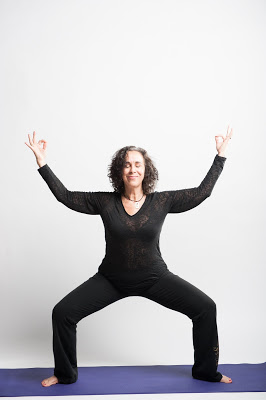by Nina
 |
| Bhavani Cooper, Age 56 |
“Leg power predicts both cognitive ageing and global brain structure, despite controlling for common genetics and early life environment shared by twins. Interventions targeted to improve leg power in the long term may help reach a universal goal of healthy cognitive ageing.” —Steves, CJ, et al.
I have to say that although I always repeat to myself what Ram wrote about the brain “what is good for the heart is good for the brain,” I am so used to thinking about the brain as somehow being separate from the rest of the body, I was flabbergasted to read about a recent study of aging twins that showed that powerful leg muscles resulting from physical exercise correlates with sharper minds. Yes, even though the brain is just another organ in your body, like your heart or your liver, we’re so used to being told that doing mental exercises, like, God forbid, crossword puzzles, is the best way to keep our brains healthy as we age, that is hard for a lot of us—me included—to take in that something like doing yoga standing poses could actually be much more effective.
In a recent study Kicking Back Cognitive Ageing: Leg Power Predicts Cognitive Ageing after Ten Years in Older Female Twins. scientists at Kings College London tested whether muscle fitness (measured by leg power, since the thigh muscles are the largest muscles in the body) could “predict cognitive change” in a healthy older population over a 10-year time period. So genetic factors could be ruled out, twins were used in the study. And because self-reporting about exercise patterns is “notoriously unreliable,” the scientist used leg strength instead as a more “objective indicator” to detect whether the test subjects had been exercising regularly or not.
The study was performed on 324 female twins (average age 55, range from 43-73). At the beginning of the study and then again 10 years later, for all the participants the scientists performed cognitive testing and for 20 pairs of identical twins, they also performed brain-imaging scans. According to the New York Times, the scientists found that those who began the study with the “sturdiest legs” showed the least “fall-off” in thinking skills, even when controlling for factors including fatty diets, high blood pressure, and shaky blood-sugar control. The Times reported that the differences in thinking skills were particularly striking within twin pairs:
“If one twin had been more powerful than the other 10 years before, she tended to be a much better thinker now. In fact, on average, a muscularly powerful twin now performed about 18 percent better on memory and other cognitive tests than her weaker sister.
“Similarly, in the brain imaging of the identical twins, if one genetically identical twin had had sturdier legs than the other at the start of the study, she now displayed significantly more brain volume and fewer “empty spaces in the brain” than her weaker sister.”
So this is very dramatic evidence about how important exercise is for maintaining cognitive health! The funny thing is that even the main author, of the study, Dr. Steves, was surprised by the results. The New York Times quoted her:
“I was quite surprised by the strength of the findings,” Dr. Steves said, “because to be honest, I am someone who has always in the past prioritized work of the mind over work of the body. This study brings home to me that the brain needs exercise to keep fit.”
For more information about the study, see Brawn and Brains (only the abstract for the study is available to general public).
Now we’ve been recommending exercise in general for cognitive health for some time now (see 6 Ways to Foster Brain Health with Yoga and Featured Sequence: Brain Health Practice). But if you’re interested in working on leg strength in your yoga practice, my post The Importance of Yoga for Strength had some basic recommendations for lower body strength. In general, though, the following are strengthening for your legs:
- Standing poses where you stand one or two bent knees, such as Powerful pose (Utkatasana), Warrior 2 pose (Virabradrasana 1), Extended Side Angle pose (Utthita Parsvakonasana), and Lunge pose
- Standing poses where you balance on one leg, such as Tree pose (Vrksasana), Half Moon pose (Arda Chandrasana), and Warrior 3 pose (Virabradrasana 3)
- Backbends where you lift your legs up away from the floor, such as Locus pose (Salabasana) and Hunting Dog pose
- Stretching poses for your legs, such as Reclined Leg Stretch (remember, stretching is also strengthening—see Just Stretching is Not Just Stretching)
Follow Yoga for Healthy Aging on Facebook ° To order Yoga for Healthy Aging: A Guide to Lifelong Well-Being, go to Amazon, Shambhala, Indie Bound or your local bookstore.


Yes! I loved reading this story as it underscores my own healing. A few years ago I was in an accident and suffered a TBI, lung blast, PTSD, central nervous system shock, etc….basically I was a mess cognitively, emotionally and physically. Drawing upon my 35 yrs. of yoga and meditation was key in my healing. By maintaining my practice, which includes daily moments of forgiveness and kindness for my new normal, I set my body up for success to self heal. My balance is sharper as is my brain. My body strengthens as does my memory. I am still amazed by the bodies ability to heal as long as we create the right environment for it to do so. Love your work and dedication to teaching. Thank you. b